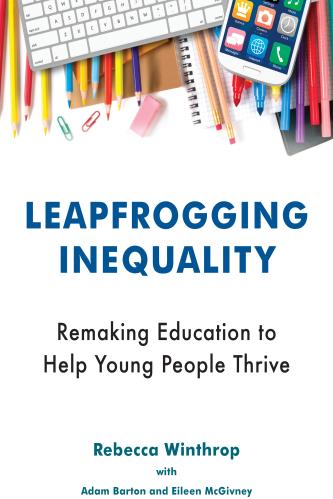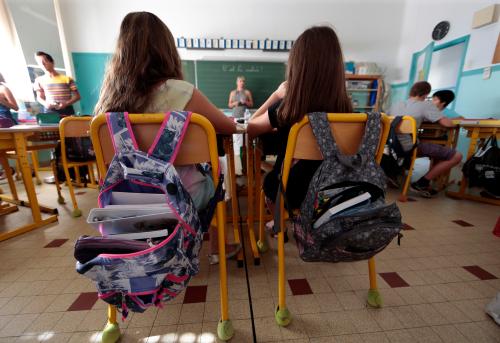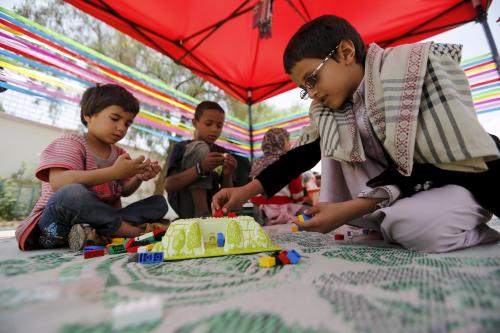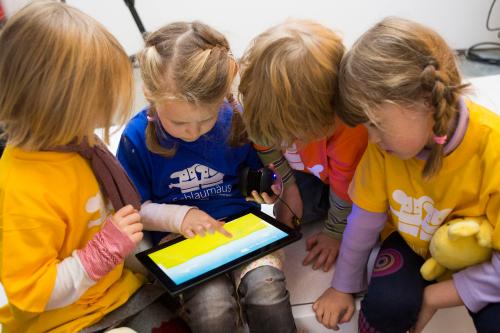This piece is a summary of the new report, “Learning to leapfrog: Innovative pedagogies to transform education.”
As the 74th session of the United Nations General Assembly (UNGA) begins, attention is focused on progress toward the Sustainable Development Goals (SDGs). With only a decade left to achieve them, it could take a century before all children are learning at the levels needed to thrive today and in the future. If we are serious about meeting SDG 4 for education, we must reframe our mindset toward the concept of leapfrogging—or rapidly accelerating education progress. New research by the Center for Universal Education (CUE) at Brookings, “Learning to leapfrog: Innovative pedagogies to transform education,” focuses on how innovations in teaching and learning can take root and scale, putting SDG 4 within reach. The report brings together previous OECD research on innovative pedagogies and CUE´s “Leapfrogging Inequality” book, to rethink and refine six innovative pedagogies that can transform teaching and learning (see figure).

Key finding 1: Innovative pedagogies are needed to transform learning
The report examines how innovative pedagogies are ripe for leapfrogging, that is, the pedagogies target skills that most impact students’ job prospects and social lives and secure the necessary depth and breadth of skills needed for lifelong learning. Many of these approaches can be used in low-resource settings and without technology, which can help close gaps in equity by helping learners who are furthest behind.
Building on the six innovative pedagogies, the report narrows in on example approaches of each. One of the approaches most ripe for leapfrogging is storytelling, an approach based on the gamification pedagogy. Storytelling can be especially impactful for teachers that base their teaching on lectures and traditional drilling, as it raises the quality of teacher narratives and engages students through powerful stories. Storytelling favors dialogue and brings together the apparently opposite “teacher-centered” and “student-centered” approaches, showing how innovation can build on teacher capacities and local beliefs.
Another approach ripe for leapfrogging is problem solving, an approach of the computational thinking pedagogy. This approach both develops a critical skill young people will need throughout their lives, and contrary to popular belief, can work well in low-tech settings. As an example, the CS Unplugged project offers off-line activities such as games, magic tricks, and competitions to show children the kind of thinking that is expected of a computer scientist. The project has become quite popular around the globe and has been translated into 12 languages, making this approach quite accessible.
Peter Tabichi, the 2019 Global Teacher Prize Winner from Kenya, shared how he uses innovations to leapfrog progress in education at the launch of the Brookings report at UNGA in September 2019.
Key finding 2: Three structural changes are needed for innovative pedagogies to flourish
Leapfrogging in education is an ambitious and challenging goal; it cannot be achieved solely through better conceptualizations and awareness of innovative pedagogies. “Learning to leapfrog” argues that policies need to be framed at multiple levels, which include teachers’ personal dispositions and skills, local conditions, and the wider national context of curriculum and policy priorities. In particular, the report calls for three structural changes for these transformations to take root:
- At the level of the teaching workforce, education decisionmakers should invest in teacher learning and professional development to ensure foundations for quality teaching. These foundations include pedagogical and content knowledge, teaching across a range of student abilities, and ample time for classroom instruction.
- Looking beyond the existing teaching workforce, education decisionmakers can widen the profile of who can be considered an educator. Doing so brings in specialized expertise and, in many cases (though not all) can “unburden” teachers from administrative responsibilities.
- The third structural change needed is to properly scaffold and manage hybrid learning environments—partnerships and models that blend formal and nonformal learning and are prevalent in today’s complex education landscape. Scaffolding through model approaches and support materials can ensure these hybrid arrangements offer quality learning that moves the needle on leapfrogging.
Key finding 3: Scaling innovative pedagogies requires systems transformation and leveraging networks
The three structural changes highlighted above point to the importance of scale, and how the adoption of innovation pedagogies will ultimately require system transformation. The report discusses how the goals of scaling should go beyond quantity of learners reached, and, rather, scale deep change, which includes altering beliefs and norms, diffusing innovation, shifting ownership to those closest to innovation, and continual learning. The report argues that one way to scale deep change is by leveraging education networks. Teachers and other education actors will undoubtedly engage and learn from their peers to implement innovative practices; thus, an important route to scaling will come through the density and dynamism of education networks, such as chains of schools, communities of practice, and teacher networks.
With a decade left to reach the SDGs, the time to leapfrog is now. We hope decisionmakers will take note of the report and its findings. It will be featured amid the many UNGA events in an afternoon discussing innovations in teaching and learning on Monday, September 23rd together with the Education Workforce Initiative, which will launch a separate report on new approaches for how the education workforce can be designed, trained, and developed.
The Brookings Institution is committed to quality, independence, and impact.
We are supported by a diverse array of funders. In line with our values and policies, each Brookings publication represents the sole views of its author(s).










Commentary
How innovations in teaching and learning help education leapfrog
September 19, 2019